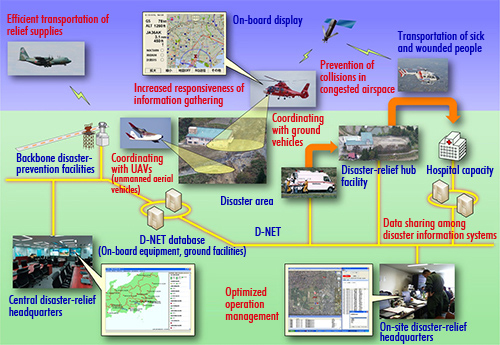Research & Development
JAXA promotes three research and development programs and a fundamental research program that underpins them.
Aircraft operation technology for disaster relief
Please visit D-NET3 for the latest news and topics on D-NET.
JAXA developed the "Disaster Relief Aircraft Information Sharing Network (D-NET)" as part of DREAMS project’s Aircraft operation technology for disaster relief . The goal of D-NET is to reduce wasted time and rescue aircraft near-misses during missions and to improve efficiency and safety by sharing necessary information among rescue aircraft and relief headquarters during disasters and by establishing optimal operations management.
Background
When a major disaster such as an earthquake occurs, numerous helicopters and other aircraft are deployed to the disaster area from all over Japan. Their missions include area observation (information gathering), search and rescue, evacuation of the sick and/or injured, transportation of personnel, equipment and material, fire fighting, etc. Currently, information among disaster-relief headquarters and aircraft is exchanged mainly through radio voice transmissions. The information is then shared using analog tools such as whiteboards at the headquarters. Because operation management and assignment of missions is human-centered, concentration of aircraft at one place at one time reduces efficiency and slows down the mission management.

Furthermore, other problems might be associated with major disasters:
- Reduced operational efficiency attributable to delays caused by multiple aircraft waiting to be refueled and to be assigned missions.
- In a wide disaster area, radio communications can be hampered by terrain obstacles (e.g. mountains) and/or congestion caused by simultaneous communications by various aircraft.
During the March 2011 Great East Japan Earthquake relief operations, over 300 helicopters were deployed to the disaster-affected areas. Both of the problems described above were observed. In addition, the pre-designated disaster relief operation base, Sendai Airport, was impaired, rendering it unusable. This fact further underscored the need for flexible decision making under emergency conditions.
Overview of "Disaster Relief Aircraft Information Sharing Network (D-NET)"
By standardizing the format of data exchanged among aircraft, disaster-relief headquarters, and disaster prevention and disaster-relief-related agencies, D-NET makes it possible to optimize operation management and mission assignment based on various information such as performance, available equipment, location, and the status of each aircraft.

Optimal operation management
In the case of a disaster, various aircraft with different equipment and performance are deployed throughout the country. Furthermore, the location and status of each aircraft must be updated constantly. D-NET enables each aircraft to be assigned its most appropriate mission and flight path. This results in decreased wasted time (e.g. time spent waiting for refueling) and improved safety because aircraft are assigned optimized flight paths that are expected to reduce the risk of mid-air collision.
Logistic operations to disaster area
D-NET is also effective in operations management such as selecting and dispatching the most appropriate aircraft from different regions around the country to the affected areas.
Because D-NET can assign an optimized flight path to each aircraft by considering weather conditions and locations of airports with refueling capacities around the country, it allows quick deployment of aircraft to the disaster area.
At JAXA, we are currently working to improve the reliability and usability of D-NET by installing the system on fire and rescue helicopters, and air ambulances and validating it through actual operations and disaster drills. In April 2014, the Fire and Disaster Management Agency started operating its Centralized Management System for Fire-fighting and Disaster-relief Helicopter Operation, which incorporates the D-NET technology.
Creating D-NET data standard
In the event of a disaster, different aircraft ranging from air ambulances and fire and rescue helicopters to Ministry of Defense, Police, and Coast Guard aircraft operate in the affected area. To share information among these aircraft, a common data format is necessary. At JAXA, we are working with many agencies to create such a common data standard and to have such data available for use in other fields, too.